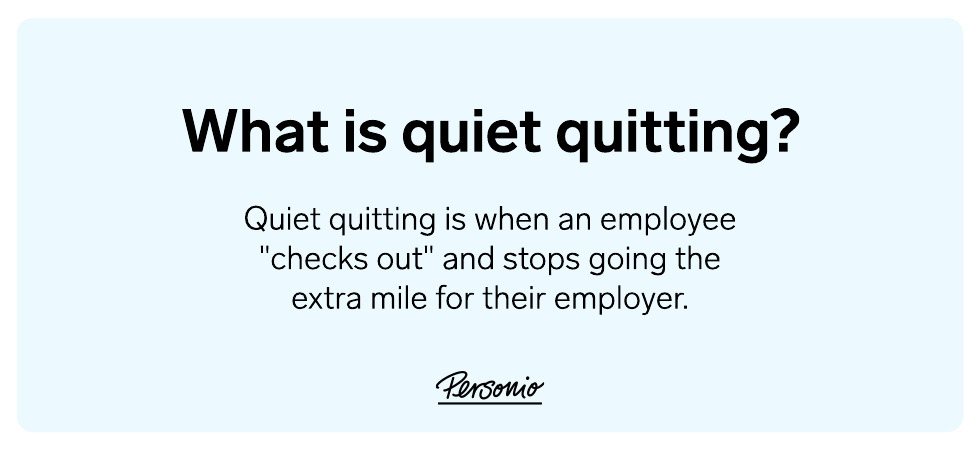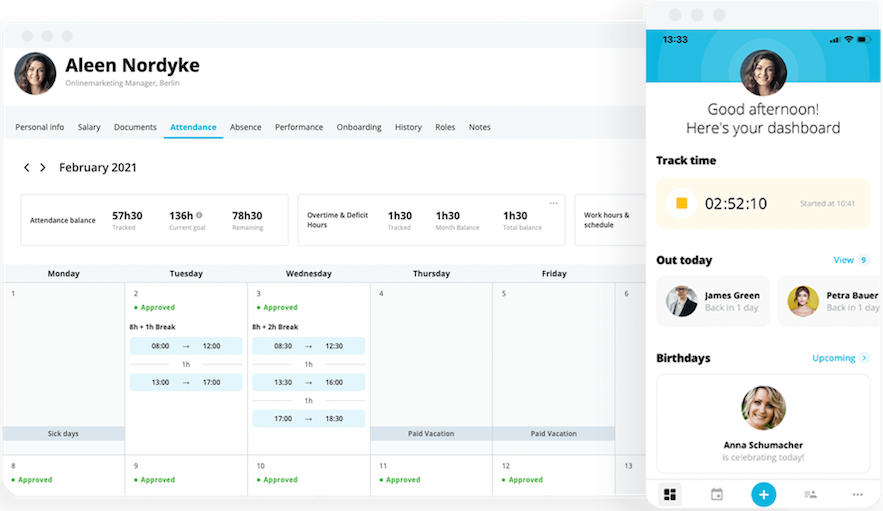Quiet Quitting: A proper guide to a very real trend

Quiet quitting is a term that went viral on TikTok in 2022. It describes employees who are fulfilling their job requirements, but not taking initiative, working overtime or volunteering for extra projects or responsibilities.
In this article, we’ll discuss everything there is to know about the quiet quitting trend, including what it looks like in practice and the steps HR teams can take to overcome it.
Key takeaways:
Quiet quitting is when employees continue to put in the minimum amount of effort to keep their jobs, but don’t go the extra mile for their employer.
This might mean not speaking up in meetings, not volunteering for tasks, and refusing to work overtime. It might also result in greater absenteeism.
Company leaders and HR teams can combat quiet quitting by creating a culture where employees feel valued, ensuring everyone understands the importance of their work and managing their expectations of their employees.
What is quiet quitting?
Quiet quitting is characterised by employees putting in the bare minimum effort to keep their jobs, but not devoting any extra time or energy to their roles. Popularised on TikTok in 2022, quiet quitting refers to employees doing their jobs just fine, but not “going the extra mile” or volunteering for anything that falls outside of their job descriptions.
The term was partly inspired by a Chinese hashtag, #TangPing, which means “lay flat” and was used to protest against the country’s prominent culture of overworking. Another driving factor for the trend is the pandemic, which caused many people to reassess how they thought about work.
If you’re seeing a lot of quiet quitting in your organisation, there could be something going on under the surface that’s causing employees to disengage (perhaps related to their work of their prospects of career progression). Figuring out what’s causing this problem — and taking steps to counteract it — should be your priority.
Is quiet quitting real?
It is difficult to know whether quiet quitting is real or just an internet phenomenon. Quiet quitting has been discussed a lot on TikTok and in the traditional media, which suggests that it’s probably real. However, it’s difficult to estimate exactly just how widespread it is occurring.
One place to start is by examining data from Gallup’s engagement polls, which ask employees to rank themselves as actively engaged, not engaged or actively disengaged at work.
According to Gallup, quiet quitters have a lot in common with those employees who are “not engaged”: they may not be actively disengaged, but they’re psychologically detached from the workplace, and they’re not working to the best of their abilities.
And, as per Gallup’s State of the Global Workforce 2022 report, only 21% of the global workforce is engaged at work, and 19% are actively disengaged.
While those who are actively disengaged are more likely to be vocal about their displeasure (and actively looking for new jobs), that leaves a whole 60% of the global working population who could potentially be ‘quitting quietly’.
Is Manual HR Slowing Down Your Organisation?

HR professionals are far more than just firefighters. But with many laden down by slow, low-value tasks, are we making the most of their expertise? Learn how to break the Cycle of HR Admin.
Get the GuideWhat does quiet quitting look like in practice?
When an employee engages in quiet quitting, they stop going above and beyond for their employer and simply do the bare minimum possible to avoid getting fired.
In practice, this might mean:
Not volunteering for extra work, leadership roles or responsibilities
Not speaking up in meetings unless addressed directly
Not responding to emails or messages outside of work hours
Turning down work outside of their job description
Becoming isolated from the rest of the team and avoiding social events
Taking a more-than-usual number of sick days (absenteeism)
How to find out if quiet quitting is happening in your workplace
Quiet quitting is by definition a subtle and almost invisible phenomenon. This means it can be difficult to prove that it’s happening in your workplace. That said, here are some things you could keep an eye on that might help you to spot quiet quitting:
Employee engagement surveys: Sending out regular employee engagement surveys (via an HR software for SMEs) can help you to spot any widespread disengagement that could indicate the presence of quiet quitters in your workplace. Keep in mind, though, that those who are not engaged at work are less likely to go out of their way to fill in surveys — so the results you get may be skewed.
Productivity metrics: When employees engage in quiet quitting, productivity usually drops. If you’re already tracking productivity metrics, you should have an idea of your organisation’s baseline, which can help you to spot quiet quitting as it happens.
Company bottom line: In extreme cases, too many employees being disengaged from work can impact a business's profitability. If your company is seeing an unexplained decrease in profits, quiet quitting is one of many possible causes to look into.
Internal promotions: People who are quiet quitting are usually not chosen for promotions or new opportunities, because they’re not seen as putting in the extra effort required. Tracking who receives promotions (and who doesn’t) can help you to spot those employees who might be quiet quitting without you realising it.
Feeling: Usually, employers know when employees are engaging in quiet quitting from a simple feeling that something isn’t right. If you feel that any of your employees don’t seem like themselves, it might be worth checking in with them.
What is quiet firing?
Quiet firing is another buzzword that’s been thrown around a lot recently, but it describes something quite different to quiet quitting.
Quiet firing is the management practice in which a manager or supervisor tries to subtly encourage an employee to quit their job. This is done by assigning them undesirable work, reducing their hours or depriving them of opportunities to advance.
This isn’t a practice to be proud of — and it shouldn’t happen in healthy work environments. However, it’s sadly quite common when employers don’t want to fire employees directly and be forced to provide a severance package, for example.
3 ways HR can respond to quiet quitting
While quiet quitting is a worrying trend that could have a big impact on productivity in your organisation, there are some things that HR and leadership teams can do to mitigate it. Here are a few things to try:
1. Work on manager engagement first
According to Gallup, only one in three managers is engaged at work. And since managers are the people who come into contact with employees every day, it’s vital to address this to stop the disengagement from spreading through the ranks of the organisation.
One important step companies can take is to reskill managers to work effectively in a remote or hybrid environment. It’s also important to ensure managers are sufficiently trained in helping employees to reduce stress and burnout — or this could lead to quiet quitting down the line.
2. Create a sense of purpose
Employees not feeling that their work has any purpose or direction is one of the key drivers of quiet quitting.
One of the most effective ways of dealing with it (or preventing it altogether) is to create a company culture where every employee understands the reasons behind their role. This should factor in to any human resources development (HRD) initiatives with your organisation.
There are many different ways to achieve this, from organising regular all-hands or town hall meetings to share updates, to distributing internal communications that focus on the company’s core mission and values. The important thing is to ensure that everyone understands how their work connects to the goals of the organisation as a whole.
3. Reward and recognise achievements
Another key reason that quiet quitting can arise is when employees don’t feel recognised for their work. This means that if you want to avoid quiet quitting, you need to ensure you’re regularly recognising and rewarding good work from your employees.
What this looks like differs from one organisation to another. For example, you might decide to set up a full-on employee recognition programme — which according to Deloitte, can increase engagement, productivity and performance by 14%. However, it could be even simpler than that: according to another Deloitte survey, three-quarters of employees would be satisfied with a simple ‘thank you’ for their everyday efforts.
Half a decade of insights on employee experience

Our "People Manual" covers all things related to employee experience and developing initiatives that result in more engaged employees. Grab your free copy right now.
Download It TodayBanish quiet quitting by respecting boundaries
Here’s a harsh truth: some employers who think they have a quiet quitting problem actually have an overworking problem.
If your employees are always expected to respond to messages out of hours, take on work that’s outside of their job description even when their calendars are full, and stay late every night just to prove their commitment, your expectations might just be too high. And you could be setting yourself up for quiet quitting from your employees down the line.
Here’s the thing: every employee needs to (properly) switch off from work when they go home — and the best managers should encourage this. Persistently ignoring your employees’ boundaries by asking them to stay late, calling them after hours or expecting them to take on extra work for no extra pay could mean they end up disengaging from their roles.
When you respect boundaries and show your employees you appreciate the work they put in, they’re much more likely to go the extra mile when it’s needed — instead of just checking out.
Meet the People Operating System
WATCH: Get to know Personio in three minutes

We need your consent to load this service!
This content is not permitted to load due to trackers that are not disclosed to the visitor.
Personio is an all-in-one HR software designed for every stage of the employee life cycle.
Using Personio, you can manage all your most important HR processes from one place. Recruit, manage, develop and pay your employees from one centralised HRIS.
For HR professionals, you can unlock new levels of productivity and influence. Become the HR business partner that your business needs, by getting back time for what matters: your people.
For line managers, Personio seamlessly builds automated performance cycles, tracks vacation days and keeps employee information up-to-date (and in a compliant fashion).
For employees, no more fussing with cumbersome tools and processes. Employees can request days off, change their information and keep track of goals and more. All from one place.
Speak with an expert today about your HR needs and how Personio can meet them. Or, give Personio a spin for yourself by starting your very own free trial right now. It’s all yours for 14 days.
Disclaimer
We would like to inform you that the contents of our website (including any legal contributions) are for non-binding informational purposes only and does not in any way constitute legal advice. The content of this information cannot and is not intended to replace individual and binding legal advice from e.g. a lawyer that addresses your specific situation. In this respect, all information provided is without guarantee of correctness, completeness and up-to-dateness.
